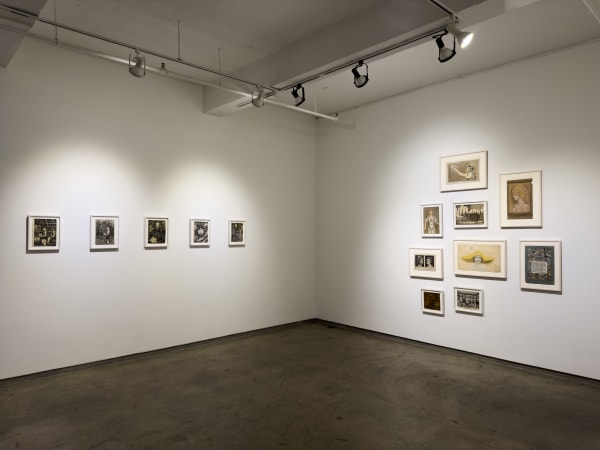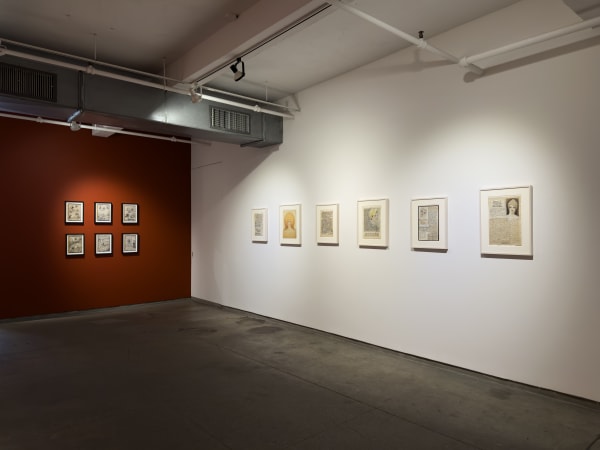Astral Projection vs. Rocaterrania: Gallery One
Ricco/Maresca Gallery proudly presents Astral Projection Vs. Rocaterrania, a revelatory juxtaposition of the work of Grant Wallace (1868–1954) and Renaldo Kuhler (1931–2013). The exhibition title is a playful nod to sci-fi epics, underscoring the contrasting approaches of these two visionary artists: Wallace’s celestial journeys and Kuhler’s meticulously grounded fictional nation converge to create a dialogue about the power of imagination as a means of resistance, self-discovery, and transcendence. Both artists rose above the limitations of everyday life, constructing intricate, immersive realities that offer profound insight into the creative process and the human psyche. This exhibition reaffirms the our dedication to championing groundbreaking artists, following its first-ever gallery shows of Wallace (Grant Wallace: Over the Psychic Radio, 2022) and Kuhler (Renaldo Kuhler: Rocaterrania, 2019). Prior to these one-person presentations, Wallace’s work had been included in The End Is Near! (American Visionary Art Museum, Baltimore, 1997–1998), while Kuhler’s appeared in exhibitions at the American Visionary Art Museum (2009), the Gregg Museum of Art + Design (Raleigh, 2011), and Halle Saint Pierre (Paris, 2013), as well as in the documentary Rocaterrania (2009) and the book The Secret World of Renaldo Kuhler (2017).
GRANT WALLACE: ASTRAL EXPLORER
Wallace’s art captures the energy of California’s spiritual avant-garde in the early 20th century, a time when Theosophy, Spiritualism, and the cosmic possibilities of modernity fueled explorations of the unknown. He sought to prove the existence of extraterrestrial life, reincarnation, and telepathic communication—beliefs that not only informed his artistic practice but also shaped his personal investigations into the occult. Wallace was deeply engaged in experiments with what he called “mental radio,” an attempt to channel messages across dimensions, blurring the boundaries between the living and the dead. His works are labyrinths of celestial alphabets, philosophical maxims, and radiant mysterious beings, serving as both records of his explorations and invitations for viewers to engage with their own spiritual possibilities. His portraits of “contacts” from Mercury, Venus, and beyond blend the mysticism of William Blake with psychedelic aesthetic, anticipating the 1960s counterculture by four decades. As Lucy Sante writes, Wallace’s visions may seem anchored in his era, but their resonance reaches far into the unknown.
RENALDO KUHLER: CREATOR OF ROCATERRANIA
In contrast, Kuhler’s Rocaterrania is a terrestrial microcosm deeply rooted in his personal history, born out of teenage isolation on a remote Colorado ranch and developed into a lifelong project complete with its own geography, government, religion, and social systems. Through its dramatic history of revolutions, oppression, and eventual democratic socialism, Kuhler encoded his struggle for independence and self-actualization, producing richly textured drawings that teem with characters, intricate architectural details, and lavish ceremonial events. A world apart yet an autobiographical mirror, Rocaterrania was, in Kuhler’s words, inseparable from his identity: “I am Rocaterrania.” Its elaborate culture extended to a fully developed language, Rocaterranski, with a distinctive alphabet and an entire linguistic framework. Kuhler’s ability to synthesize influences from history, Victorian aesthetics, and Art Deco design into his fictional state underscores his extraordinary imagination and analogical thinking, while its political evolution—from monarchy to democratic socialism—paralleled his own path toward self-realization.
TWO WORLDS, TWO VISIONARIES
Grant Wallace, a newspaper illustrator turned occult explorer, attuned his “mental radio” to the astral plane, channeling complex diagrams, portraits, and texts that revealed his spiritual dialogues with extraterrestrial beings, dead historical figures, and enlightened entities from distant realms. Renaldo Kuhler, a scientific illustrator, envisioned Rocaterrania—a sovereign nation of his imagination—born from a longing to escape the isolation and constraints of his youth. Both artists demonstrated extraordinary meticulousness, rich detail, and limitless creativity in shaping their respective worlds—one extending into the cosmos, the other delving into symbolic narratives of personal and historical transformation.
Wallace’s career as a newspaper illustrator and reporter immersed him in storytelling and diagrammatic thinking, both of which became integral to his oeuvre. Similarly, Kuhler’s work as a scientific illustrator honed his eye for detail, a skill reflected in the sophisticated maps, architecture, and characters of Rocaterrania. These parallel professional experiences brought discipline and precision to their fantastical creations, anchoring the surreal in a level of technical mastery that makes their work all the more compelling.
Click here to visit the online viewing room for this show and learn more about the works exhibited.








